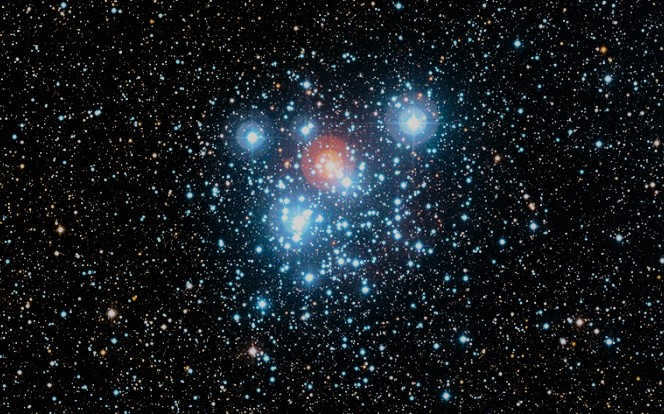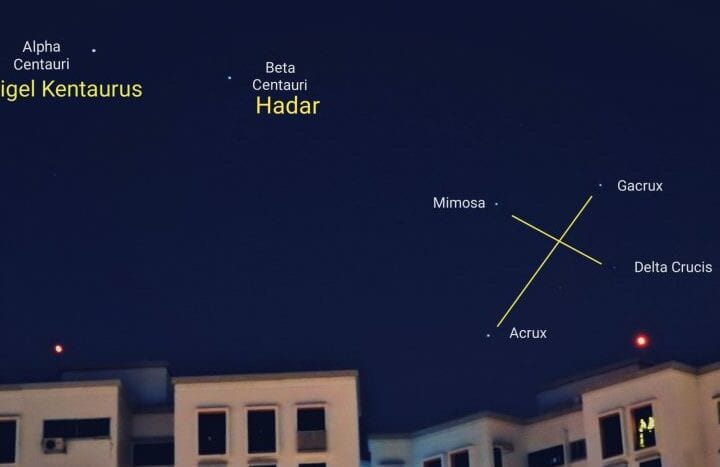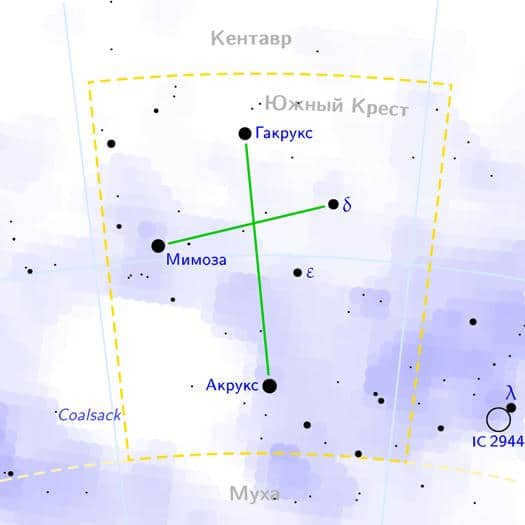When stargazing in the southern hemisphere, one can easily spot the Southern Cross, which is the most distinctive asterism in this region. Consisting of five stars that form the shape of a cross, this constellation is instantly recognizable and serves as the defining feature of the Southern Cross constellation, the smallest constellation in the night sky. Interestingly, this asterism is notable for having only two prominent stars, Akruks and Hakruks, which act as a guide, pointing towards the South Celestial Pole.
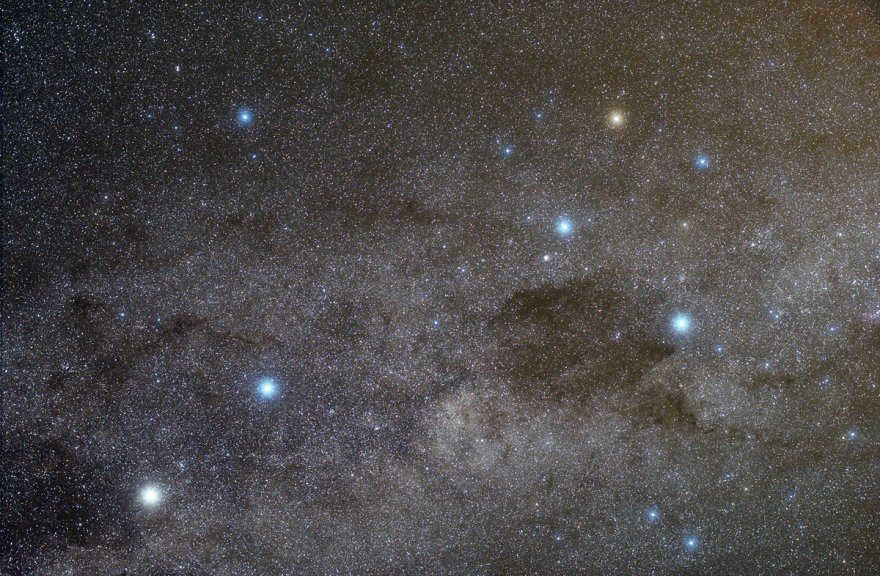

Locating the Southern Cross in the night sky is a simple task and holds significant meaning for numerous cultures. The stars of this asterism are prominently featured on the flags of Australia, New Zealand, Papua New Guinea, Samoa, and Brazil. Additionally, the Southern Cross is referenced in the national anthems of Australia and Brazil.
Due to the fact that the asterism known as the Southern Cross is significantly more conspicuous than the constellation Southern Cross, there is often confusion between the two (given that the constellation contains more than 5 stars). The stars comprising the asterism are the most brilliant within the constellation, and the distinctive cruciform shape can be observed in the southern latitudes at any time throughout the year. Those residing in the tropical latitudes of the northern hemisphere have the opportunity to admire this celestial feature near the horizon during the winter and spring seasons, albeit only for a limited number of hours.
Stars
The five stars of the Southern Cross, namely Alpha, Beta, Gamma, Delta, and Epsilon, create a pattern that resembles a snake rather than a cross. Among these stars, Alpha, Beta, and Delta belong to the Scorpius-Centaurus Association. They have spectral classes O and B, share a common motion, and were formed in a single giant molecular cloud. These stars are relatively young, with an estimated age of 10-20 million years.
Akruks, also known as Alpha Southern Cross or HD 108248, is a system of multiple stars. It has a total apparent magnitude of 0.77, making it the brightest star in the constellation. Akruks is located at a distance of 321 light-years and holds the title of being the most southerly first magnitude star, even closer to the south than Alpha Centauri. With an absolute magnitude of -4.14, it shines brightly in the night sky.
The system consists of two distinct components that can be visually distinguished, with a separation of 4 angular seconds. Alpha-1 has a visual magnitude of 1.40, while Alpha-2 has a visual magnitude of 2.09. Both stars belong to the O class, with Alpha-1 classified as B0.5IV and Alpha-2 classified as B1V. The surface temperatures of these stars are 28,000 K and 26,000 K respectively, and they are 25,000 and 16,000 times brighter than the sun.
The name Akruks is a shortened form of Bayer’s Alpha Southern Cross, a name that has been used since the mid-20th century.
Akruks is located at a latitude of -63° and is only visible south of 27° S. In Portugal, it is referred to as the Star of Magellan.
Mimosa (Beta Southern Cross) is a binary star system with an apparent magnitude of 1.25 (the second brightest in the constellation and the 19th brightest in the sky) and is located approximately 280 light-years away. It can be observed at latitudes below -60 ° and is not visible north of 30 °N. The name “Mimosa” is derived from Latin and is likely inspired by the flower of the same name.
It is recognized as the hottest star among those with a magnitude of one. Mimosa is classified as a Beta Cepheus variable, meaning it exhibits pulsations that vary in intensity and frequency. These pulsations occur at three distinct periods. The star is composed of two components that are too close together to be distinguished in a telescope. They orbit each other with a period of approximately five years.
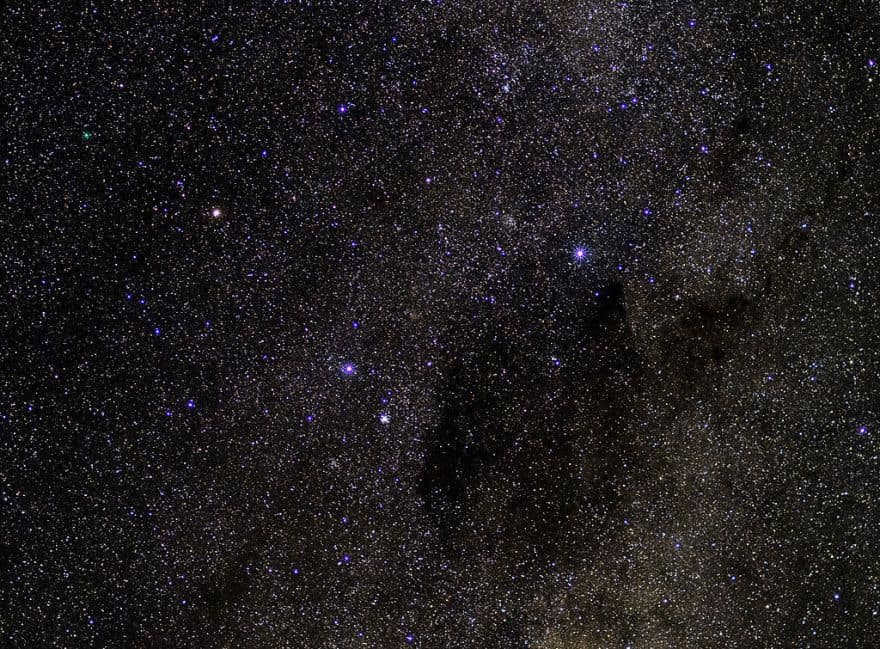
The constellation known as the Southern Cross and the dark nebula known as the Coal Sack can be observed in the night sky.
The Southern Cross is estimated to be between 8-11 million years old. It consists of a blue-white giant star (B0.5 III) as its main component, and a main-sequence star (B2) as its companion. In 2007, a third object was discovered, which is a pre-main-sequence star with two optical companions nearby. Although they appear to be aligned, there is no physical connection between them.
Delta Southern Cross is a blue-white subgiant that is transitioning into a red giant (B2 IV). It has a visual magnitude of 2.79 and is located 345 light-years away. Its rotational velocity is 210 km/s. It is 8.9 times the mass of the Sun and 10,000 times brighter. It is also classified as a Beta Cepheus-type variable star.
Epsilon of the Southern Cross is a type of star known as an orange giant (K3III) that has a visual magnitude of 3.56 and is located approximately 228 light-years away. This particular star has a mass that is 1.42 times that of our sun and a radius that is 32.9 times larger.

Location
The Southern Cross is situated in close proximity to the constellation Centaurus, which envelops it on three sides. It is also adjacent to the Fly. To locate this group of stars, begin by identifying Alpha and Beta Centauri. Trace a line from the former to the latter, and you will encounter the Gamma star of the Southern Cross.
This group of stars spans a mere 6 degrees from north to south (slightly more than the distance between Merak and Dubhe, which points towards Polaris). In order to observe the Southern Cross, one must reside in the southern hemisphere or in a location not far south of 25°S, where it becomes visible above the horizon. In tropical latitudes, these stars can be seen from the months of April through June.
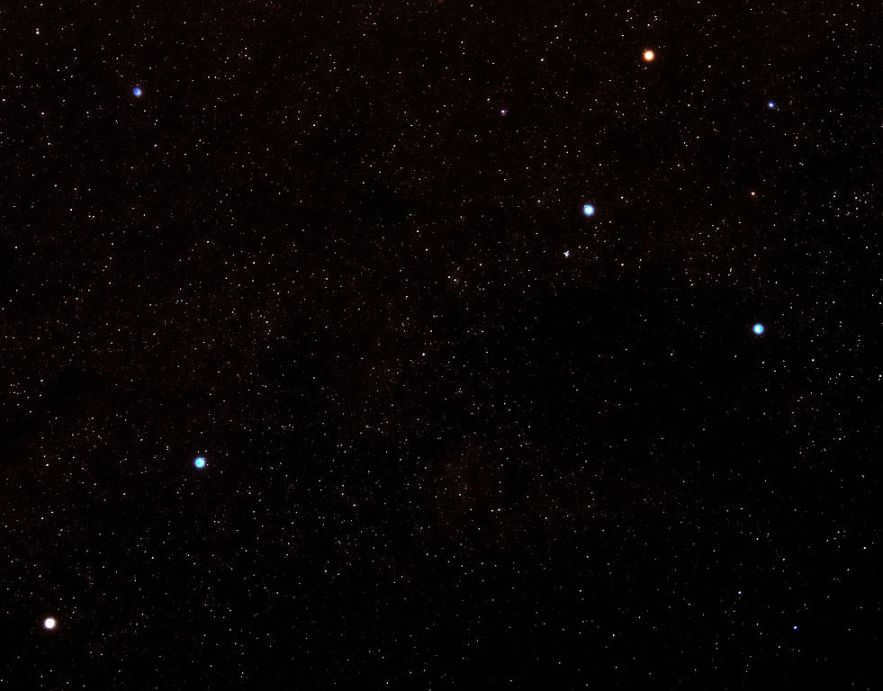
The Southern Cross can be located in the night sky by following the direction of Alpha and Beta Centauri. This constellation is positioned opposite Cassiopeia and cannot be observed simultaneously. However, individuals residing south of 34° latitude can enjoy the sight of these stars throughout the year, as the Southern Cross is a circumpolar constellation that remains above the horizon at all times. It is important to note that the Southern Cross should not be mistaken for the False Cross, which consists of four bright stars from the Sails and Kiel constellations. Unlike the Southern Cross, the False Cross does not point towards the South Celestial Pole. However, in the year 8600, the False Cross will shift towards the east and intersect with the branches of the Southern Cross, potentially marking the position of the pole.
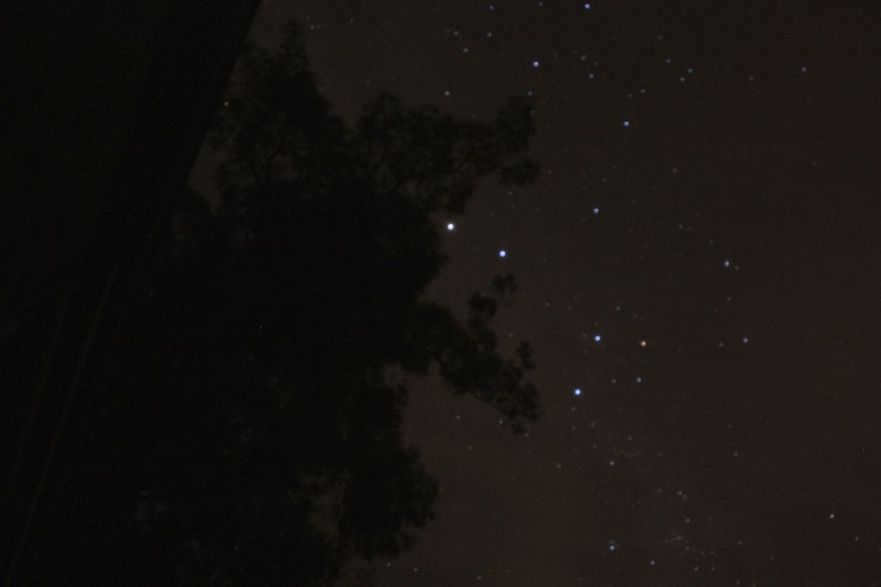
The Southern Cross was photographed using a 30-second exposure.
Interesting Information
The Southern Cross has held significant importance for various cultures and civilizations throughout history. Both the Egyptians and Aborigines regarded this constellation with reverence and wonder. In ancient Egypt, it was believed to represent the location where Horus, the Sun Goddess, was crucified. The Maori people associated the Southern Cross with animistic spirits, while the aborigines believed it resembled the head of an emu.
The Southern Cross, known as “Chacana” to the Incas, was discovered even on Machu Picchu. The Incas referred to it as a “ladder” representing the three levels of the world: the heavens, the world of the living, and the underworld. Approximately 5,000 years ago, it was visible in the northern hemisphere, including regions such as North America, Babylon, and Greece.
Historical records indicate that the asterism was initially documented in ancient Greece around 1000 BC. It was believed to be a part of Centauri and could only be observed from Athens at that time, positioned low in the sky. As the precession of the equinoxes occurred, the constellations dipped below the horizon, revealing 5 bright stars to European observers. Richard Allen, an expert in stellar nomenclature during the 19th century, noted that the last time these stars were visible on the horizon was during the crucifixion of Christ in Jerusalem.
At this time, the separation of Centauri and the Southern Cross occurred. The exact person responsible for this procedure is unknown, but it is speculated that it could have been carried out by Peter Plancius in 1613 or Augustin Royer in 1679.
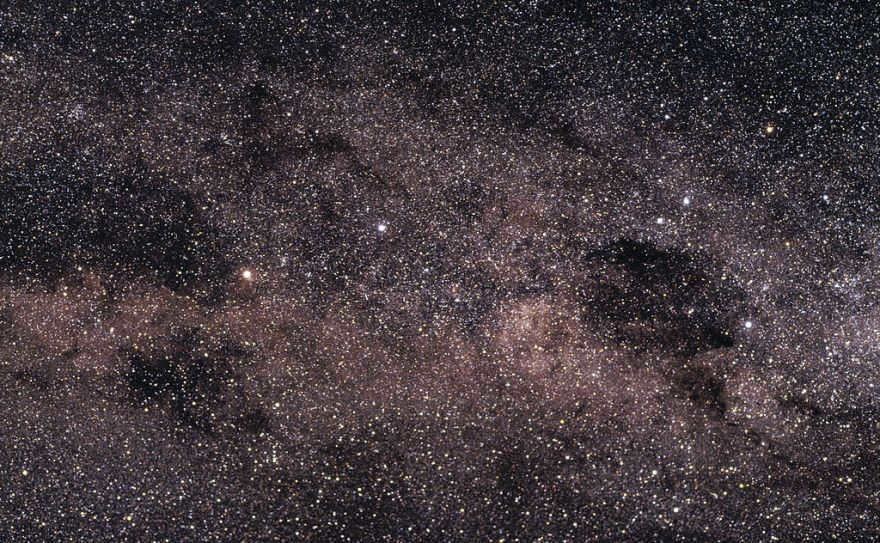

The visual representation showcases the vicinity encompassing the Southern Cross, including Alpha Centauri, a vibrant yellow star (situated towards the middle left).
How to Locate the South Using the Southern Cross Asterism
The Southern Cross serves a practical purpose in helping to locate the South Celestial Pole. By following the longer rod of the asterism, one can determine the direction of the South Pole. This specific point is sometimes referred to by aviators and sailors as the “south polar hole” due to the absence of bright stars in that area.
Another method to find the South Celestial Pole involves drawing a line between Alpha and Beta Centauri and extending it until it intersects with a line connecting Alpha and Gamma of the Southern Cross. To get a better understanding of the Southern Cross asterism, you can examine the provided photo. Additionally, our website offers a star map that can be helpful. Online 3D models are also available for exploring other asterisms, constellations, and the brightest stars in galaxies.
The Southern Cross is a constellation located in the southern region of the sky. It is the smallest out of all 88 constellations.
However, despite this fact, the constellation in question is renowned as one of the most prominent in the southern hemisphere. It comprises a cross-shaped group of stars that are among the brightest in the night sky. The Southern Cross holds significant cultural significance for numerous societies in the southern hemisphere and has left an indelible mark on their histories. It is particularly significant to Australia and New Zealand, as it is visible throughout the year due to its circumpolar nature.
In the northern hemisphere, you won’t be able to spot the Southern Cross constellation if you go north of +20°. To catch a glimpse of it, you have to turn your gaze towards the circumpolar south at 34° because it never dips below the horizon. This constellation is positioned directly across from the Cassiopeia constellation. Its name, Crux, is derived from the Latin word for “cross”. In ancient Greece, it was believed to be a part of the Centaurus constellation. Even though these stars were depicted on celestial globes, it wasn’t until 1679 that the Southern Cross became recognized as its own constellation, thanks to the efforts of Augustin Royer, a French astronomer. Some argue that the credit should actually go to Peter Plancius, an astronomer from Holland, who created it in 1613 and had it published by Jacob Bartsch in 1624.
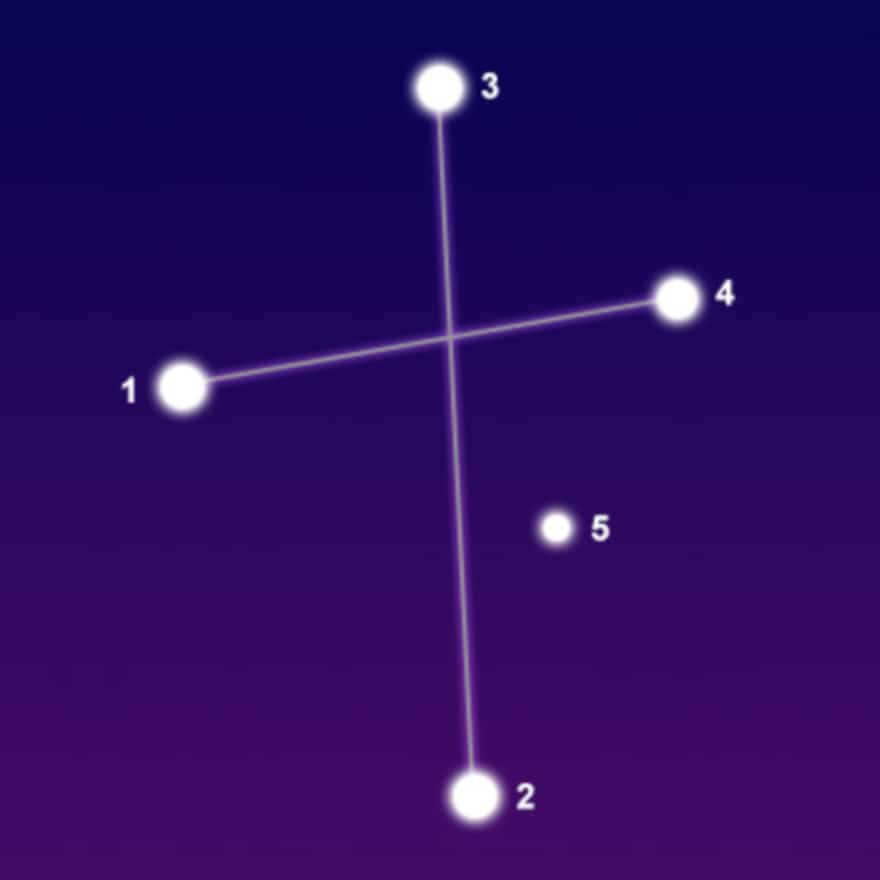
Facts, Position, and Map
The constellation Southern Cross is known as the smallest constellation and is ranked 88th. It covers the third quadrant in the southern hemisphere (SQ3) and can be located at latitudes ranging from +20° to -90°. It shares its borders with Centaurus and the Fly.
This constellation is home to a star with a planet and does not contain any Messier objects. The brightest star in Southern Cross is Acrux, which has an apparent magnitude of 0.77. Acrux is also the 12th brightest star in the sky. Additionally, there is a meteor stream in this constellation called Crucidae. Southern Cross is part of the Hercules group, which also includes Sacrilege, Eagle, Centaurus, Raven, Cup, Swan, Hercules, Hydra, Lyra, Arrow, Shield, Sextant, Serpent, Fox, Southern Triangle, Serpentine, Wolf, and Southern Crown. To get a better understanding of the constellation Southern Cross, refer to the diagram on the star map.
Legend
The Southern Cross is a highly popular constellation. In ancient Greece, it was believed to be a part of Centaurus. It was visible before the stars dipped below the horizon line in Europe and the northern hemisphere. Many people associated it with the crucifixion of Christ, considering it to be of great significance. Ptolemy, in the second century, documented all the stars of the Southern Cross in the Centauri region. However, the constellation remained unknown to most Europeans until the late 15th and early 16th centuries when naval expeditions began exploring new territories.
The stone figure of the star pattern was observed in Machu Picchu (Peru). It was called Chacana, which means “Ladder” in the Inca civilization, and Te Punga, which means “anchor” in the Maori culture. The Australian Aborigines interpreted it as the head of an Emu in the sky. Furthermore, the Southern Cross is prominently featured on the national flags of Australia and Brazil. It is also mentioned in the Brazilian national anthem and has been used as the currency name in Brazil during certain time periods.
In 1501, Amerigo Vespucci first noticed these stars, but a more accurate depiction was made in 1515 by Andrea Corsali. The Southern Cross was depicted on globes created by Peter Plancius in 1598 (based on observations by Peter Dirkszoon) and Jodocus Hondius in 1600.
Notable celestial bodies
Discover the prominent celestial bodies within the constellation known as the Southern Cross in the southern hemisphere. This collection provides in-depth explanations, captivating images, and detailed characterizations.
Acrux (Alpha Crucis) – assumes the top position in terms of luminosity within the constellation and ranks twelfth in the night sky. It possesses an apparent visual magnitude of 0.77 and is located approximately 320 light years away. Acrux is comprised of a multiple star system, including Alpha-1 (a B-type subgiant) and Alpha-2 (a B-type dwarf). These two stars are separated by a distance of 4 angular seconds. Both stars emit intense heat and are classified as nearly O-class, boasting luminosities 25,000 and 16,000 times greater than that of our Sun, respectively.
Alpha-1 is considered a spectroscopic double, consisting of two objects with magnitudes of 14th and 10th, which orbit one another every 76 days. Additionally, there is another B-class subgiant star within this system; however, it is positioned at a greater distance along the same line of sight.
With a declination of -63°, Acrux holds the distinction of being the most southern star of first magnitude. Its visibility is limited to areas south of 27° latitude, making it an important celestial object for many countries in the southern hemisphere. Acrux is prominently featured on the flags of Australia, Papua New Guinea, and New Zealand, alongside the other four stars of the Southern Cross. Additionally, it is one of the 27 stars that symbolize different nations on the flag of Brazil, specifically representing São Paulo.
Mimosa, also known as Becrux or Beta Southern Cross, is a spectroscopic binary system composed of two stars located 8 astronomical units apart and orbiting each other over a period of 5 years. The primary star of this system has a spectral type of B0.5IV, making it one of the hottest first magnitude stars.
With a visible magnitude of 1.30, it holds the second position in the constellation and is ranked 20th in the night sky. Situated 350 light-years from our solar system, this star is known as a Beta Cepheid variable. It can only be observed in regions located south of the Tropic of Cancer (23°26'16'). With an age of 10 million years, it has been given the name “Mimosa” due to its unique color. Interestingly, this star represents the state of Rio de Janeiro on the flag of Brazil.
Hakruks (Gamma of the Southern Cross) is classified as a red giant (M4III) with a visible magnitude of 1.59 and a distance of 88 light-years. Among the stars in the constellation, it ranks as the third brightest and holds the 26th position in the night sky. This star is a double star system, composed of a main body belonging to the spectral class M4 III, and a companion white star of class A3, which has a visual magnitude of 6.4. Interestingly, the companion star is located 400 light-years away from the main body.
Zeta of the Southern Cross is a binary star system made up of a dwarf star that shines with a blue-white color (B2.5 V) and a companion star that has a magnitude of 12.49. The combined visual magnitude of the system is 4.04. This stellar duo is situated at a distance of 360 light years from our Sun.
Epsilon of the Southern Cross, on the other hand, is an enormous star that glows with an orange hue and belongs to the giant star category (K3III). It has a visual magnitude of 3.56 and is located 228 light years away. Interestingly, Epsilon of the Southern Cross is prominently featured on the flag of Brazil, where it symbolizes the state of Espirito Santo.
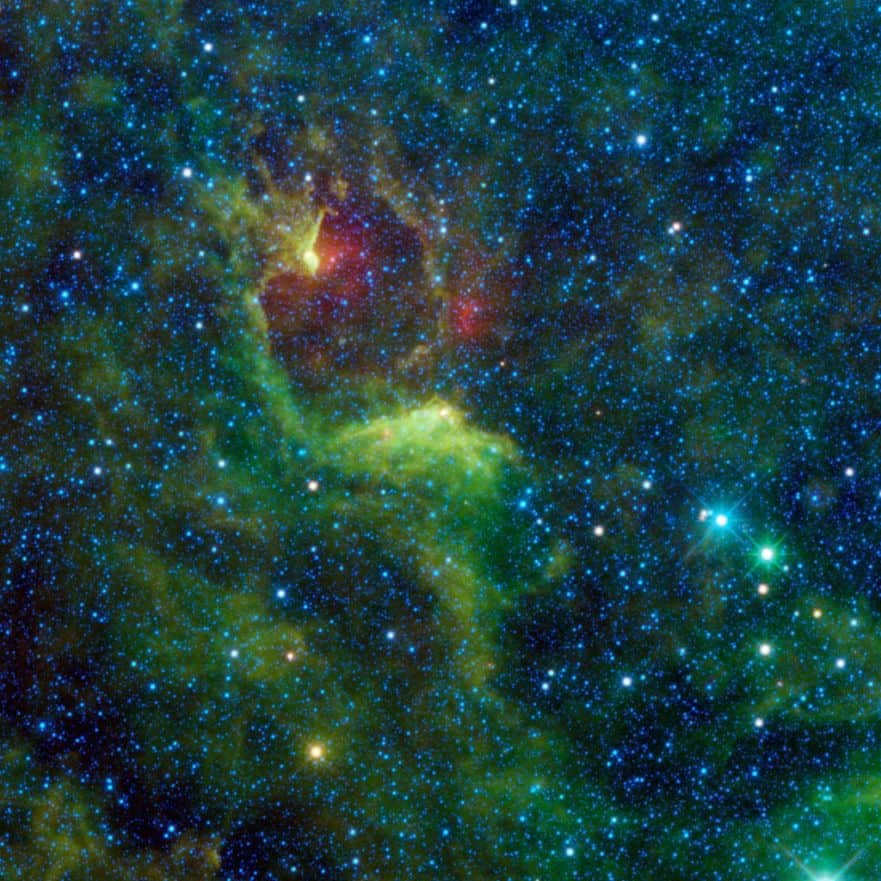

The Epsilon star of the Southern Cross (bright blue star on the right) and the IRAS 12116-6001 reflective nebula (green) are shown in this image. The presence of interstellar dust cannot be observed in visible light, but it has been captured using WISE detectors in infrared wavelengths. IRAS 12116-6001 is a carbon star that is nearing the end of its life cycle. The blue color represents emission at 3.4 and 4.6 microns, and the green color represents emission at 12 microns.
There are two separate star systems that go by the name Theta of the Southern Cross.
Theta-1 is a double star system of the Am spectral class, with a visual magnitude of 4.30 and a distance of 230 light years.
Theta-2 is also a double star system, with the two bodies orbiting each other every 3.4280 days. It is classified as B2 IV and is located 750 light years away. Its apparent magnitude is 4.72. One of the stars in this system is the variable Beta Cepheus, whose luminosity varies between 4.70 and 4.74.
Lambda of the Southern Cross is a blue-white dwarf (B4Vne) with an apparent magnitude of 4.6. It is located 360 light years away. This star is also a variable Beta Cepheus, with its brightness fluctuating by 0.02 magnitude over a period of 0.3951 days due to surface pulsation.
Iota of the Southern Cross is a large orange star (K0 III) with a visual brightness of 4.69 and a distance of 125 light-years. This star has a secondary star in its vicinity, a G8 class star with a brightness of 10.8.
BZ of the Southern Cross (HD 110432) is a subgiant star of the B-class that exhibits emission lines in its spectrum. It belongs to the category of Gamma Cassiopeia-type variable stars, which means it has a disk of gas surrounding its equator. Additionally, it emits X-rays and has a brightness of 5.316, appearing to be 1000 light years away. It can be found behind the Coal Sack Nebula.
NGC 4349-127 is a gigantic red star that is around 20 times more massive than Jupiter. It is located at a distance of 7077 light-years from us. Its apparent brightness is 7.4, while its absolute brightness is -4.3. In 2007, astronomers discovered a companion star, which is a brown dwarf.
Celestial entities
The Coal Sack Nebula (Caldwell 99) is a celestial entity characterized as a significant dark nebula in the southern portion of the Milky Way. It presents itself as a sizable black region spanning approximately 7 by 5 degrees of the sky, traversing through the adjacent constellations Centauri and Fly. Its radius measures between 30 and 35 light years, and it is situated at a distance of 600 light years from Earth.
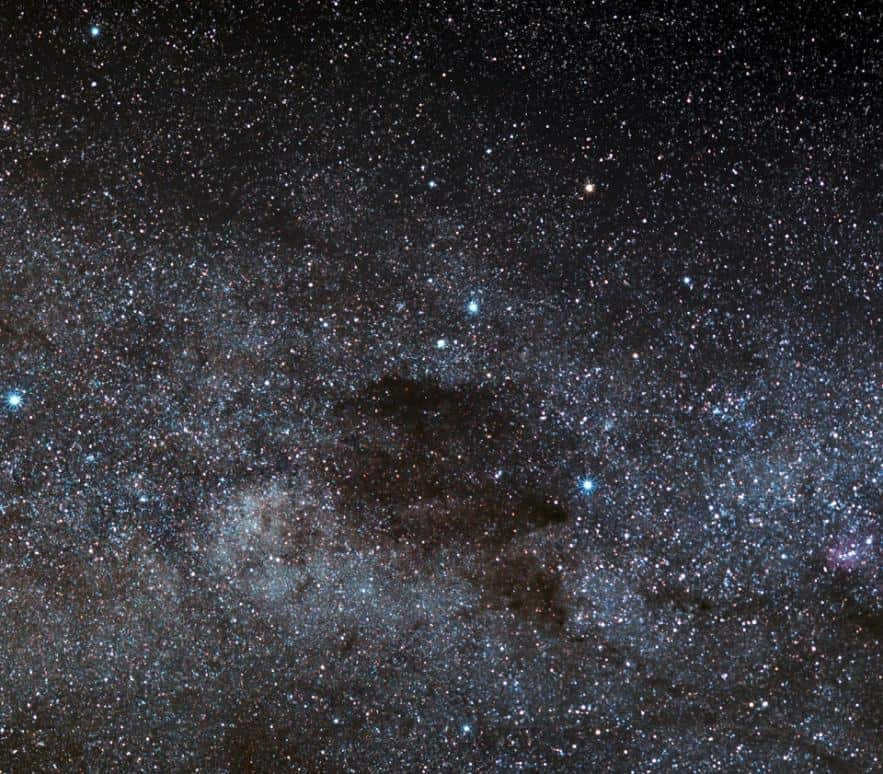
Because of its immense size, the nebula has been observable since ancient times in the southern hemisphere. It was referred to as the Dark Canopus by Amerigo Vespucci. The Australian Aborigines perceived it as the head of an emu, a bird that plays a prominent role in numerous legends and myths.
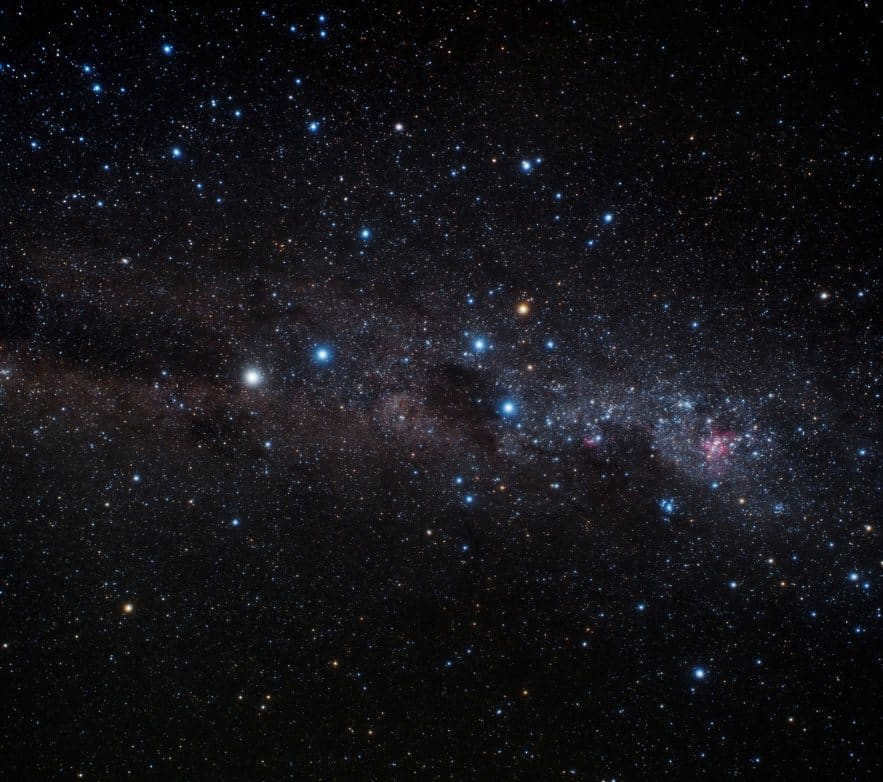
The Nebula known as the Coal Sack and NGC 4755 (located to the right of the center above the nebula).
The NGC 4755, also known as the Jewel Box or Caldwell 94, is a star cluster that is open in nature. This particular cluster is considered to be one of the youngest, with an age of approximately 14 million years.
With a visual magnitude of 4.2, the Jewel Box contains roughly 100 stars. It is located at a distance of 6440 light-years from our solar system and can only be observed from the southern hemisphere. The cluster was first discovered by Nicolo Louis de Lacaille during his trip to South Africa between 1751 and 1752. John Herschel, upon observing the cluster through a telescope, described it as resembling a box filled with multicolored gemstones.
At first glance, the cluster bears a resemblance to the star Betacrux, which is one of the stars that make up the Southern Cross. The supergiants in the cluster are the brightest stars, with the three brightest being referred to as “traffic lights” due to their distinct colors. The most dominant star in the cluster is Kappa of the Southern Cross (HD 111973), a red M-type supergiant with a visual magnitude of 5.98. It stands out significantly from the other stars in the cluster, which are mostly blue.
This cluster is located approximately 1700 light-years away and has an absolute magnitude of -6.0.
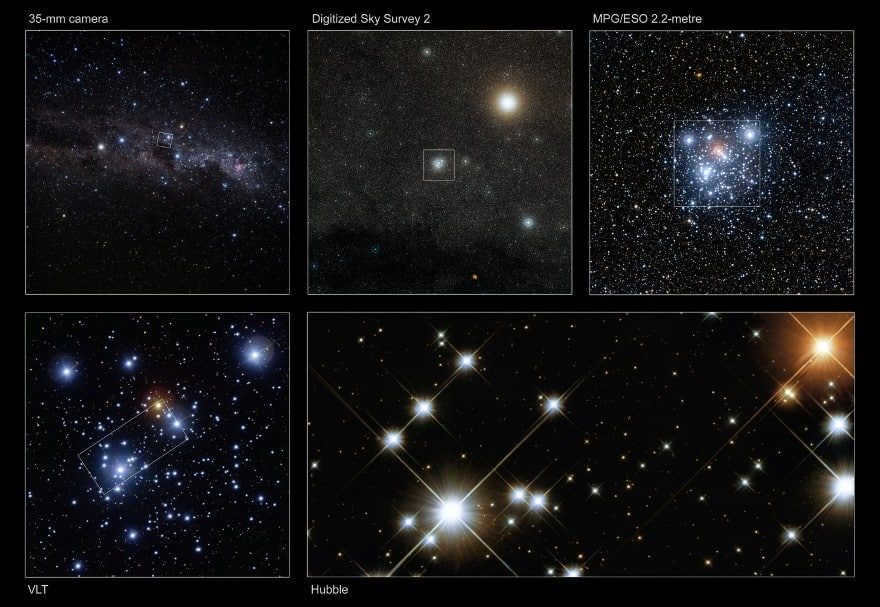

This composite image reveals the vast star field where NGC 4755 can be found. It provides a glimpse into the diverse magnification levels achieved by various telescopes.
To explore the Southern Cross constellation in greater detail, you can utilize not only our photographs but also 3D models and online telescopes. If you prefer a more hands-on approach, a star map will suffice for your personal search.
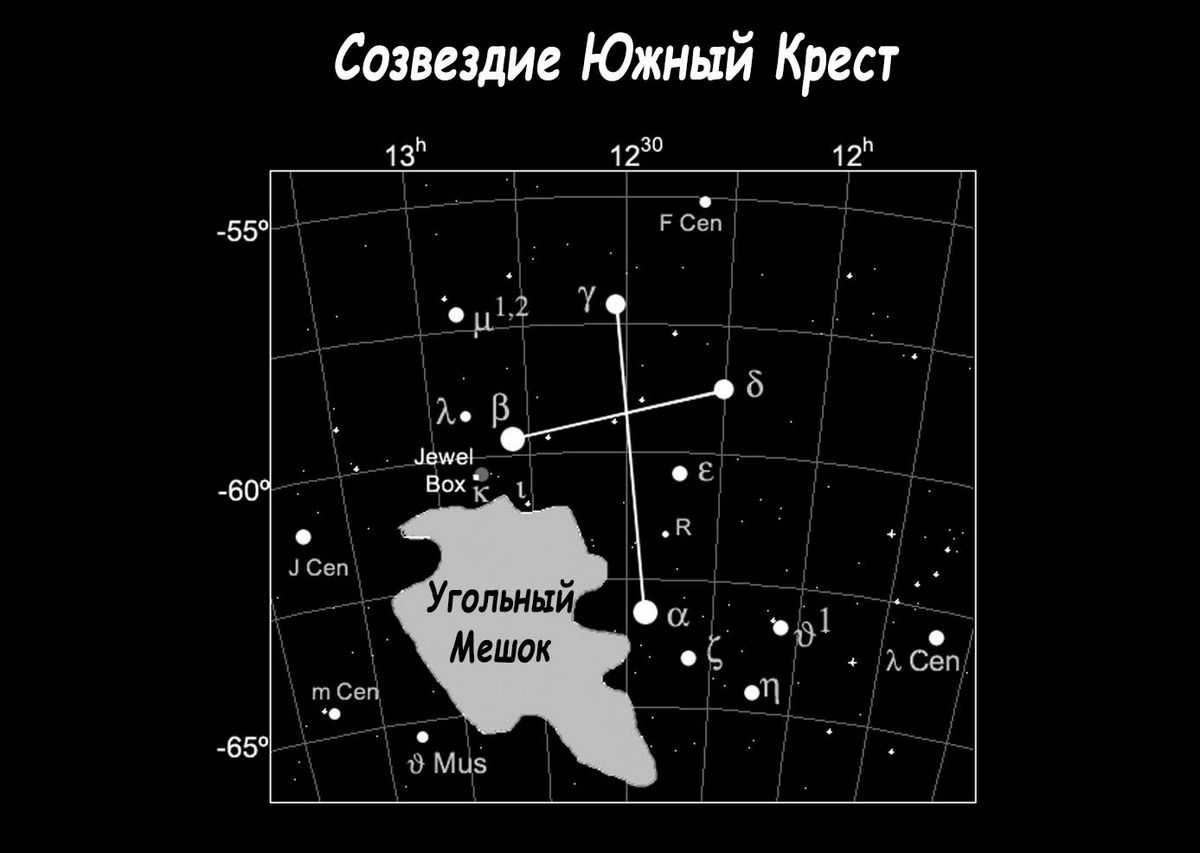
The Southern Cross constellation is the smallest constellation in terms of its size, but it possesses an astonishing beauty.
Youthful, diminutive, yet incredibly stunning
When observing the night sky in the southern hemisphere with the naked eye, one can easily locate approximately thirty stars that form this constellation. However, the majority of these stars emit a faint glow. Among them, only four of the brightest stars – α, β, and γ of the Southern Cross (with a first stellar magnitude) and δ (with a second stellar magnitude) – create a distinct shape in the sky resembling a cross.
The “Coal Sack” and the “Box of Diamonds”
The “Coal Sack” and the “Box of Diamonds” are two fascinating celestial formations in the night sky. These two objects, although they have contrasting names, are both incredibly beautiful and captivating.
The “Coal Sack” is a dark region in the southern constellation of Crux. It appears as a large, dark patch against the backdrop of stars. Despite its name, the “Coal Sack” is not actually composed of coal or any other material. Instead, it is a dense cloud of gas and dust that obscures the light from stars behind it. The “Coal Sack” is thought to be a remnant of a supernova explosion, and its dark appearance is due to the absorption and scattering of starlight.
On the other hand, the “Box of Diamonds” is a cluster of stars located in the constellation of Crux as well. It is named for its resemblance to a box of sparkling diamonds. The stars within the “Box of Diamonds” cluster are relatively young and hot, emitting a brilliant white light. This cluster is also known as the Jewel Box, and it is a popular target for amateur astronomers due to its stunning visual appearance.
Both the “Coal Sack” and the “Box of Diamonds” serve as reminders of the vastness and beauty of the universe. While one is a dark region that hides the light of stars, the other is a cluster of stars that shines with dazzling brilliance. These celestial formations are just a small glimpse into the wonders that exist beyond our planet, and they continue to inspire and captivate those who study and observe the night sky.
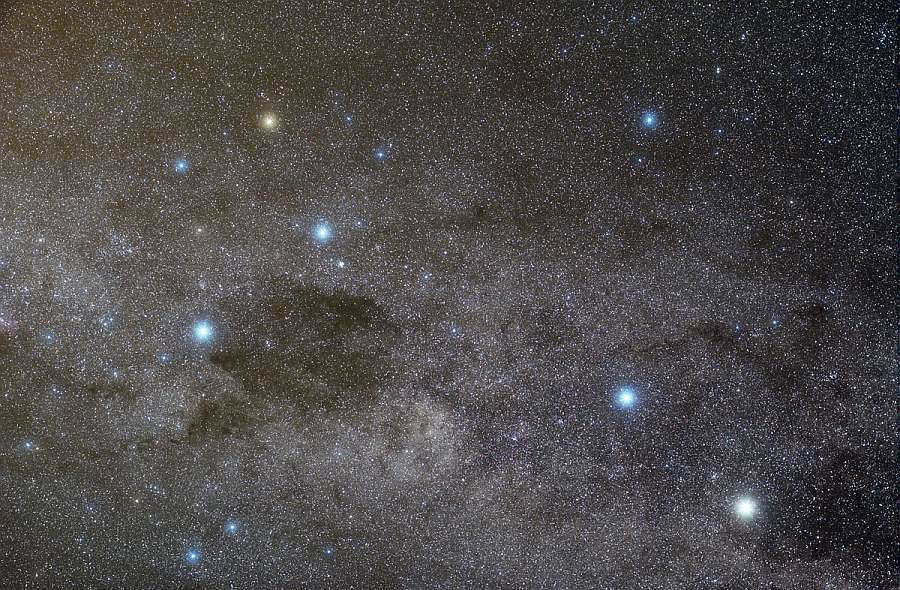
Photograph of the Coal Sack Dark Nebula
The Coal Sack is a dark nebula located within the Southern Cross constellation, which is one of the closest dark nebulae to Earth. It is situated approximately 490 light years away. The Coal Sack consists of a dense cloud of cosmic dust that absorbs the light emitted by distant stars, resulting in a visible dark spot amidst the brighter Milky Way. These clusters of cosmic dust, including the Coal Sack, not only scatter and absorb radiation, but also have the ability to polarize it.
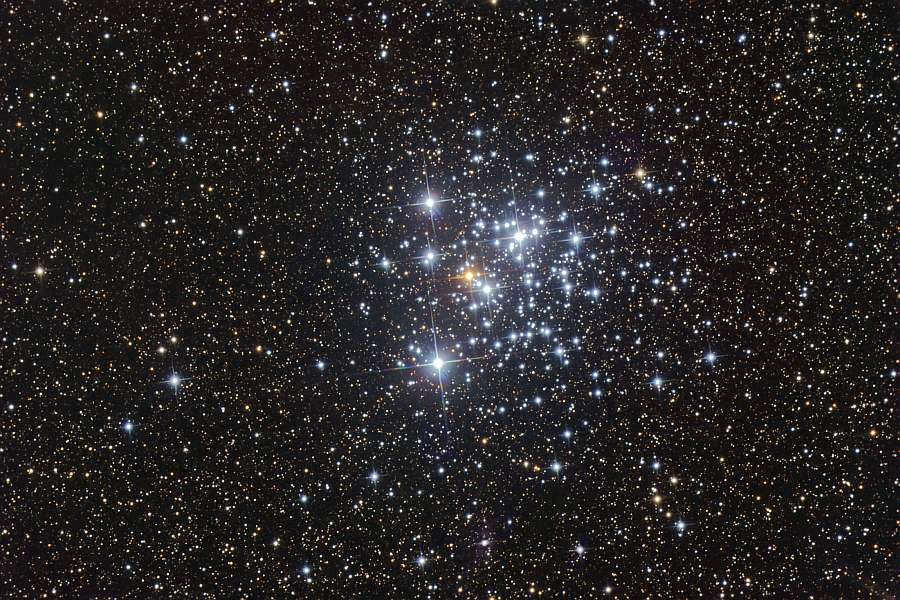
NGC 4755, also known as “The Box of Diamonds,” is a scattered cluster located in the eastern part of the sky. This cluster consists of a small group of stars with vibrant and diverse colors, creating a stunning display in the night sky. The combined luminosity of all the stars in this cluster is 5.2 magnitudes. NGC 4755 is situated at a distance of over 7500 light years away from Earth. It was discovered by the French astronomer Nicola Louis de Lacaille during his observations in southern Africa between 1751 and 1752.
Location in the celestial sphere
The position of the Southern Cross constellation in Russia is not visible due to its placement being far from the celestial equator, specifically in the southern region. Surrounding the “Cross” from the east, north, and west are the stars of Centaurus (Centaurus), while its southern side neighbors the “Fly”. Identifying this constellation is quite simple as it forms a bright and distinct shape. Additionally, a pair of relatively bright Centauri stars, Rigil Centaurus (a Centauri) and Hadar (b Centauri), located slightly to the east of the Southern Cross, can assist in locating it. By drawing an imaginary straight line westward through these stars, one can directly point towards the Southern Cross.
While it’s relatively easy to determine the location of the North Pole (just look for Polaris), finding the South Pole is a bit more challenging. Unlike the North Pole, there isn’t a bright star like Polaris nearby. Additionally, the South Pole is not located in the constellation Southern Cross, as many people believe, but rather in the unremarkable constellation Octanthus. The closest star that can be seen with the naked eye is Sigma Octanthus, but it’s not bright enough to serve as a navigational polar star. As a result, a more complex method had to be developed, which involves using the distinctive bright stars of the Southern Cross as a guide.
Finding the Southernmost Point on Earth
In order to locate the southernmost point on Earth, one must draw a line connecting the stars Hakruks and Akruks, which form the constellation Southern Cross. Extend this line from Akruks approximately 4.5 times, and the resulting point will be the southernmost point on Earth. To confirm this finding, one can also draw an imaginary line from the midpoint of the line connecting Alpha Centauri (Toliman) and Hadar. The point where these lines intersect will be the South Pole, and there will be a faint, barely visible star called Sigma Octantha nearby.
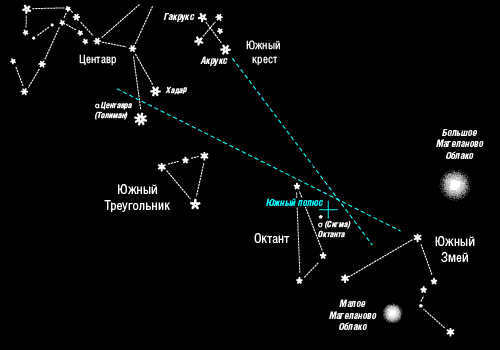
If you join Hakruks and Akruks and extend the line approximately 4.5 times from Akruks, you will find that this point indicates the location of the South Pole.
An alternative method
If you locate Canopus (the second brightest star in the sky, after Sirius) and Ahernar in the Eridanus constellation, and then form an equilateral triangle using the line connecting them as the base, the third point of this triangle will indicate the position of the South Pole.
By the way:
We can say that time does not exist at the North and South Poles of the Earth! Since the Sun never sets there (or more accurately, sets only once a year), and all meridians converge, you have the freedom to choose any time zone to determine the time and live according to its time. Typically, the countdown from Greenwich is used as a reference.
The Moon behaves in a similar manner to the Sun, but it does not set once a year, rather it sets once during each lunar month.
The Moon behaves like the Sun, but it sets not once a year but once during a lunar month.
Alternative method to discover
Similar to the previous technique, you will have to create a perfect equilateral triangle, but this time using the Large and Small Magellanic Clouds as the vertices for the other two corners.
Incidentally:
The stars located at the poles always maintain a consistent height, and regardless of the season, the celestial image remains unchanged, with the constellations seen remaining the same as they revolve around the pole.

Indeed, the Southern Cross is the tiniest constellation. In reality, it only covers an area of 68 square degrees. That means, among all the known sky areas worldwide, it ranks 88th in terms of size.
As its name suggests, this constellation can be found in the southern hemisphere. Its neighboring constellations include Centaurus and the Fly. Furthermore, it is positioned opposite Cassiopeia.
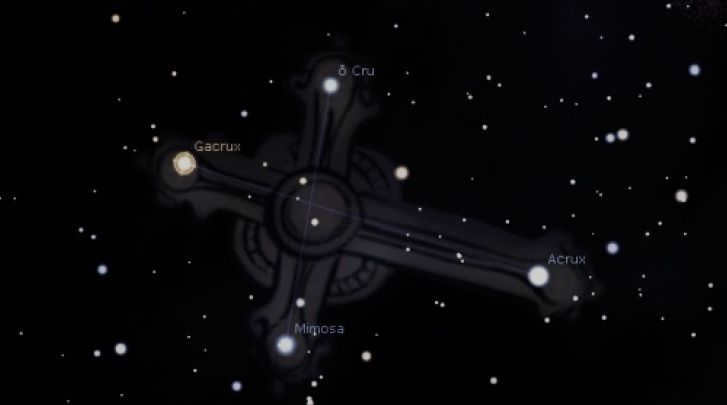
Etymology
The southern constellation that was once regarded as an asterism has a fascinating origin. In the annals of Roman astronomy, it was referred to as the Throne of the Emperor. Presumably, this moniker was bestowed to pay homage to Augustus, the visionary behind the empire’s establishment.

However, it was quite common in ancient texts to categorize the constellation Southern Cross as part of Centaurus. In such instances, it was referred to as an asterism known as the New Cross.
Only over time did the exploration of space lead to the recognition of this area as a distinct constellation.
Nevertheless, constellations in the southern hemisphere, including the Southern Cross, have always been utilized for orientation and navigation.
Legend
Interestingly, European mythology does not attribute the constellation of the southern hemisphere to any gods or mythical figures.
According to one interpretation, the constellation represents an animal that attempted to escape from an evil spirit by taking refuge in a tree.
In the Australian culture, the luminous stars of the constellation were believed to resemble two cockatoos trying to ascend the tree. This is likely how the four-star figure was perceived by people.
If the stars only appeared in the sky once every thousand years, how passionately people would believe in and worship them!
Ralph Emerson
In addition to this, there exists the tale of the male and female individuals. Per ancient folklore, they were brought into existence by the celestial ruler Bayame. He instructed them to consume vegetation. However, a drought occurred one day. At that moment, one man killed a rodent. Subsequently, he and the woman partook in consuming the flesh.
Nevertheless, the second man declined. He distanced himself from his companions. After some time, the couple noticed their friend’s absence and pursued him. A famished man collapsed near a colossal white eucalyptus tree. Suddenly, out of nowhere, a dark creature with blazing eyes materialized. It was the embodiment of death, known as Yowie. He seized the lifeless body and tossed it into the cavity of the tree.

Suddenly, a bolt of lightning struck and ripped the eucalyptus tree out of the ground. It soared through the air, with two majestic white Muyi cockatoos trailing behind it. Eventually, the tree came to a halt near the vast expanse of the Milky Way, which was believed to be a pathway to the realm of the gods. In that moment, the eucalyptus vanished, and in its place appeared four blazing eyes. Legend has it that two of the eyes belonged to a spirit, while the other two belonged to a departed soul.
Ever since that event, death has walked among us. The constellation in the southern hemisphere serves as a constant reminder of this eternal truth.
The stars that make up the Southern Cross constellation
There are several notable stars within the Southern Cross constellation:
One of the brightest stars in the constellation is Alpha, also known as Acrux. It is actually a multiple star system and is ranked 12th in terms of brightness among all the stars.
Beta, or Becrux, is another prominent star in the constellation. It is also referred to as Mimosa and is interestingly a binary spectroscopic system consisting of two stars.
Gamma, also known as Gacrux, is a red giant within the Southern Cross.
Lastly, Delta, or Decrux, is a subgiant star. It is classified as a Beta Cepheus type variable star.
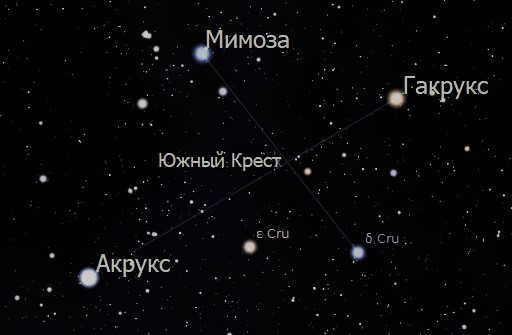
Zeta is a binary star system consisting of a small blue-white dwarf and its companion star.
For instance, Epsilon and Iota are classified as orange giant stars.
Theta is composed of two star systems:
One is a lambda dwarf star with a blue-white hue. It is also classified as a Beta Cepheus variable star.
Additionally, the list of stars in the southern constellation includes the subgiant star BZ and the red giant star NGC 4349-127.
Objects in the Southern Cross Constellation
Aside from the prominent stars, there has been a recent discovery of a dark nebula within the boundaries of the constellation known as the Coal Sack. This celestial object is also referred to as Caldwell 99. It is remarkable for its considerable size, which made it notable even to astronomers of ancient times.
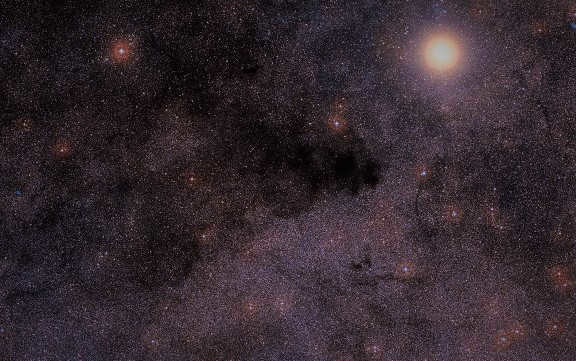
There is another fascinating location in this region. It is an open star cluster known as The gem box (or Caldwell 94.). Interestingly, this cluster is the most recent addition. It is a mere 14 million years old. Scientists estimate that it contains approximately 100 stars. However, this magnificent cluster can only be observed from the southern hemisphere.
Incidentally, the Southern Cross possesses a meteor stream called Crucidae.
